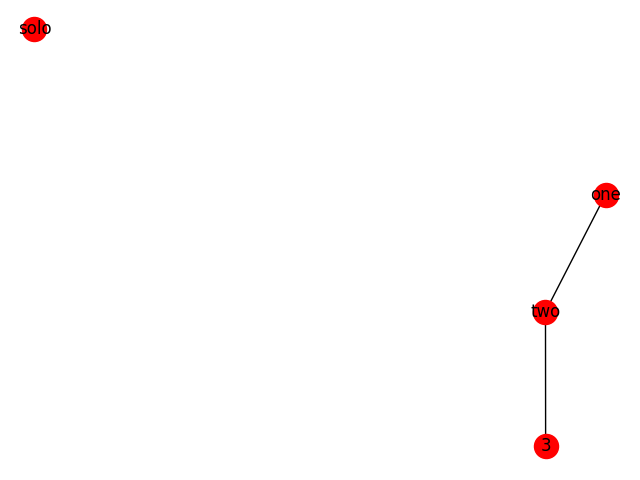Rgraph¶
An example showing how to use the JavaScript InfoVis Toolkit (JIT) JSON export
See the JIT documentation and examples at http://thejit.org

Out:
[
{
"data": {},
"id": "solo",
"name": "solo"
},
{
"adjacencies": [
{
"nodeTo": "two",
"data": {
"type": "extra special"
}
}
],
"data": {},
"id": 3,
"name": 3
},
{
"adjacencies": [
{
"nodeTo": 3,
"data": {
"type": "extra special"
}
},
{
"nodeTo": "one",
"data": {}
}
],
"data": {
"type": "special"
},
"id": "two",
"name": "two"
},
{
"adjacencies": [
{
"nodeTo": "two",
"data": {}
}
],
"data": {
"type": "normal"
},
"id": "one",
"name": "one"
}
]
Nodes: [(u'solo', {}), (3, {}), (u'two', {u'type': u'special'}), (u'one', {u'type': u'normal'})]
Edges: [(3, u'two', {u'type': u'extra special'}), (u'two', u'one', {})]
__author__ = """Ollie Glass (ollieglaskovik@gmail.com)"""
import json
import matplotlib.pyplot as plt
import networkx as nx
from networkx.readwrite.json_graph import jit_data, jit_graph
# add some nodes to a graph
G = nx.Graph()
G.add_node("one", type="normal")
G.add_node("two", type="special")
G.add_node("solo")
# add edges
G.add_edge("one", "two")
G.add_edge("two", 3, type="extra special")
# convert to JIT JSON
jit_json = jit_data(G, indent=4)
print(jit_json)
X = jit_graph(json.loads(jit_json))
print("Nodes: %s" % list(X.nodes(data=True)))
print("Edges: %s" % list(X.edges(data=True)))
nx.draw(G, with_labels=True)
plt.show()
Total running time of the script: ( 0 minutes 0.199 seconds)